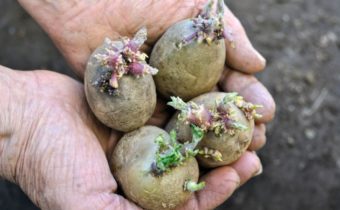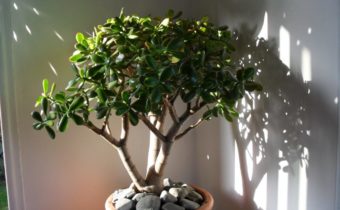Tomato tree "Cifomandra" - is it a tomato?
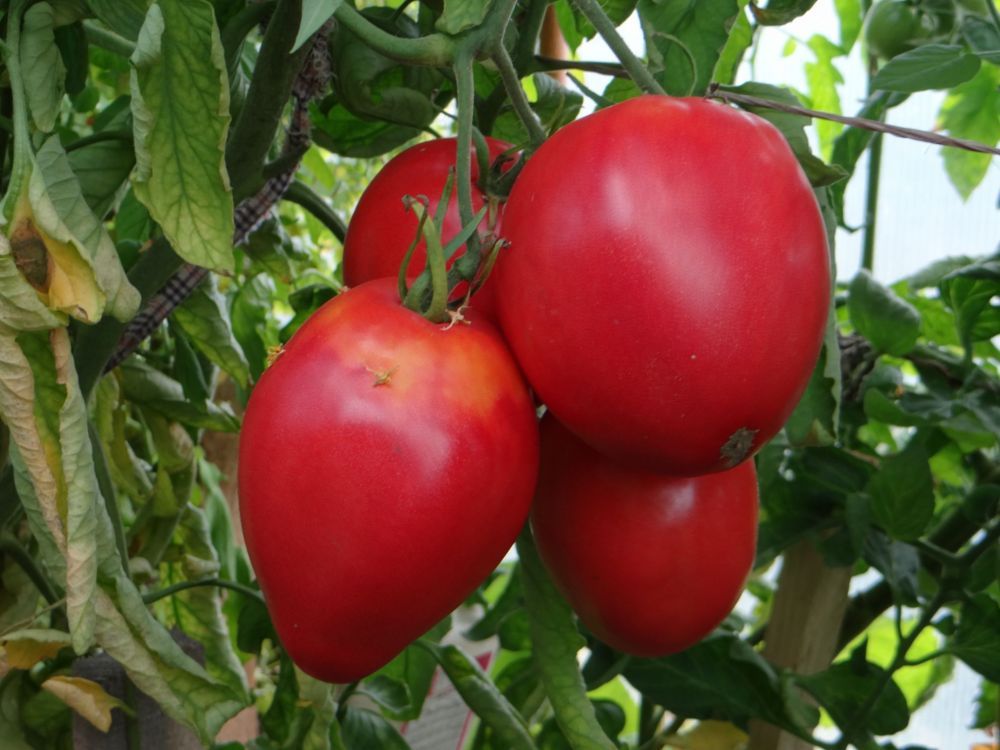
Tomato tree - “Cifomandra” refers to the family of nightshade, as is familiar to us tomato, eggplant, potatoes or peppers. Why "tomato"?
Apparently, because its fruits are similar to small tomatoes, although there is still a controversial question: “Who does the fruit look more like, a tomato or a fruit?”
general information
"Digomandra" or "tamarillo" refers to the genus of warren and has incorporated all the properties of this species. It grows rapidly, acquiring the form of a spreading tree, the leaves are large, up to 30 cm, slightly elongated, thin and unlike tomato leaves, most likely resemble an elongated heart.
Tamarillo flowers, exactly like eggplant and potato flowers: with five sharp petals from pale pink to lilac, and gathered into small inflorescences.
 The plant is subtropical, thermophilic, does not tolerate even light frosts. It can grow both in open ground and in greenhouses. “Digomandra” is an evergreen perennial, in a warm climate it grows and bears fruit for a long time, up to 6–8 years.
The plant is subtropical, thermophilic, does not tolerate even light frosts. It can grow both in open ground and in greenhouses. “Digomandra” is an evergreen perennial, in a warm climate it grows and bears fruit for a long time, up to 6–8 years.
A tree grown from seeds enters fructification only from the second year, therefore it is not suitable for planting in open ground in the middle lane because it will have to be dug out for the winter.
Fruits of unusual taste, varied in color inside and out. The taste of the fruit depends on the variety: sometimes sour or sweet.
The harvest is good, it can reach up to 30 kg per tree, at least three years old, but the return is gradual.
This exotic tree practically does not get sick, it doesn’t scare even a phytophthora, but in greenhouses it can be infected with whitefly or thrips.
See also: What does the taste of tomatoes depend on, how to get a fragrant crop?
Characteristics and description
Description of the bush
Tomato tree "Cifomandra" exactly corresponds to its name.
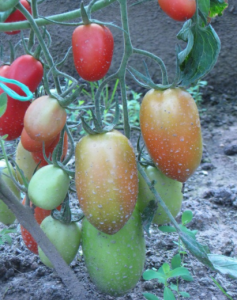
- It looks like a tree: at first, the trunk grows quickly, the grove is below, and at the top a crown of shoots is formed. Formed in the same way as in real trees.
- The trunk of an adult tree reaches a diameter of five to eight centimeters, and branches - up to 3 cm.
- The tree looks impressive: it serves as an ornament to any garden, greenhouse, veranda and apartment, where it grows in large containers.
- Tomato tree is decorated with large beautiful leaves and bright fruits.
- It is afraid of low temperatures: even with a short fall to +2 ° C, drops the leaves and young shoots die, but after the temperature rises, it is gaining strength again, so it is recommended to grow in heated greenhouses or only until autumn.
- He likes the sunny side, does not develop in the shade and does not reach large sizes.
Fruit Description
Fruits of a grade of "Tsifomandra" are a little similar to tomatoes. They resemble, most likely, exotic fruits.
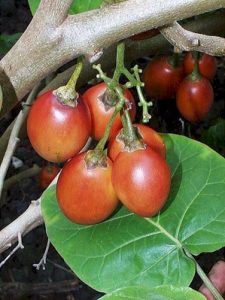
- Have an unusual color of the pulp. It can be dark, gray with red skin, or yellow with an orange top.
- The fruits themselves are distinguished by a variety of colors: pink-crimson, red, yellow, olive, lemon and similar to beets. How many varieties, so many colors.
- Pulp juicy, interesting exotic taste, but pleasant, shades of fruit: passion fruit, lemon, strawberry and tomato.
- Fruits are like large plums or eggs, hanging on a long stalk. Grow from a few to twenty pieces in a brush.Their size is about 5 cm in width and up to 10 cm in length. The weight of one fruit is from 30 to 50 g.
- The skin of the fetus is hard, tasteless, bitter.
And in order to use the fruits in food entirely, it is necessary to remove the skin from them. To do this, the fruits are scalded with boiling water, keep them in it for about a minute, after which the skin can be easily removed.
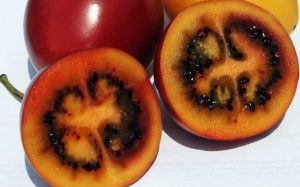
- Peeled fruits are widely used in cooking. Of them prepare salads, mashed potatoes, mousses, all that is made from real tomatoes, and more sweet desserts: jams, marmalade, decorate the sponge cake and ice cream. You can pickle like regular tomatoes.
- Excellently stored in frozen form, retaining all the beneficial properties and vitamins, which are enough in this fruit: vitamins of group B, vitamins A and C, PP, potassium, magnesium and other trace elements.
See also: Tomato "Black Cluster F1" - is it necessary in the garden?
Advantages and disadvantages
You have learned that the fruit of this tomato "Tsifomandra", its characteristics and description of the variety, now consider all the advantages and disadvantages of this plant.
Consider the merits of tomato tree.

- High-yielding, from one tree is possible for the season, which lasts seven months, to collect from 20 to 30 kg of fruit.
- Exotic fruits of unusual taste, good for health: there are no contraindications, as they have low caloric content, without fats and carbohydrates. Unlike other fruits, they can be eaten even by people with diabetes.
- The plant decoratively looks, is decoration of any greenhouse and garden.
- Well propagated by seeds and cuttings.
- You can grow at home, on the loggia and in the winter garden all year round.
- Practically not ill.
- Can grow on a glazed loggia in a pot, if she looks to the south side.
What can be attributed to the shortcomings of the tomato "tsifomandra" guided by the description of the variety.
- If you celebrate its large crop, you should not forget about the area of this tomato tree, and, recalculated to square meters, you can doubt the yield.
- Fruits only in the second year: it means that it is suitable for our gardeners relatively. The tree will have to be transported into the room for the winter, if there is no heated greenhouse, take care of it all winter and take it to the site in the spring.
- When transplanting, transporting for the winter from open ground to home, one does not have to wait for a high yield. It should be treated simply as an exotic plant.
- Fruits fall when ripe, so it is important to remove them from the tree in time.
- Fruits can not be stored: a maximum of two weeks, provided the refrigerator.
- The tree is demanding for the temperature regime: at low temperatures, leaves and flowers are shed, therefore, in winter greenhouses and loggias, it is necessary to maintain the temperature not lower than 10–15 ° C.
- As it turned out, all the same there are more minuses in the tomato “tsifomandra”, although its reviews and photos are very attractive and tempting for people.
Features of growing varieties
How to grow a tomato tree?
Grow it easy, most importantly, to determine where it will continue to grow. Since “tsifomandra” refers to solanaceous crops, then it should be grown according to the same principles.
Take the soil for sowing light but fertile: into 2 parts of humus, one part of sand and peat. If you can not do yourself, buy ready-made land for vegetables.
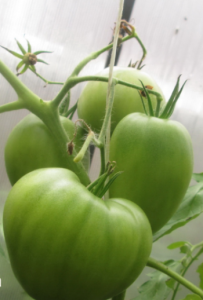 Before sowing, place the seeds in the refrigerator for a day for hardening. Then pickle them in a solution of potassium permanganate for 1 hour.
Before sowing, place the seeds in the refrigerator for a day for hardening. Then pickle them in a solution of potassium permanganate for 1 hour.
Seeds can be germinated at any time of the year, but as gardeners recommend, the best time is early spring. Then the seedlings will not need additional coverage. They are planted in a small container to a depth of 1 cm, between the seeds - 5 cm, covered with glass or plastic film and put in a warm place, not necessarily bright.
But as soon as the seedlings appear in a week or two, the tray with the seedlings is immediately rearranged into the light.The temperature should be 20–22 ° C during the day and 16 ° C at night so that the sprouts do not stretch. After the appearance of two leaves, the seedlings dive, transplanting into separate pots very carefully, because the roots are very tender.
The seedling grows very quickly and actively, it needs fertilizing with mineral fertilizers.
- Superphosphate: 3 g per liter;
- Potassium nitrate: 3 g per liter of warm water. Or use integrated ready-made feedings.
Planted in a pot or soil, with the appearance of 7-8 leaves. The first year, if flowers appear, they should be cut off to form a strong tree.
In the open field he needs a great support, better trellis. Plant in a light ground, make a hole with a depth of at least 25 cm. At the bottom pour a liter of humus, a liter - peat, a liter - ashes, mix, spill with warm water and fill up with mulch after planting.
See also: The original way of growing tomatoes up roots
In the summer, in a greenhouse or in the open field, caring for a tree is no different from growing a normal tomato.
 From open ground, the plant must be transplanted into a container, wide but shallow. The root system of the tomato "Tsifomandra" superficial, does not like too much moisture. Therefore, pour drainage 5 cm thick at the bottom of the pot, provide holes on the sides below for ventilation and for oxygen to reach the roots. A large pot tray is required.
From open ground, the plant must be transplanted into a container, wide but shallow. The root system of the tomato "Tsifomandra" superficial, does not like too much moisture. Therefore, pour drainage 5 cm thick at the bottom of the pot, provide holes on the sides below for ventilation and for oxygen to reach the roots. A large pot tray is required.
To set the pot in a bright room until spring or to a permanent place where it will continue to grow and bear fruit “cytomandra” - a tomato tree. Now get acquainted with the method of growing from the cutting.
It is even easier to grow Tsifokandr from cuttings.
Put the cuttings in the water, where you can drip the solution of biohumus and follow as soon as the trunk appears thickening, the makings of the roots, immediately put in pots with fertile soil.
Before planting, spill the earth with a solution of potassium permanganate to disinfect it. From above, you must wear a transparent bag to create a microclimate. Once the plant has taken root in a month, you can remove the shelter.
 To care as for normal seedlings: feeding every other week, moderate watering. The plant will grow quickly and bush. Often, according to reviews, such a plant begins to bear fruit in the first year of life.
To care as for normal seedlings: feeding every other week, moderate watering. The plant will grow quickly and bush. Often, according to reviews, such a plant begins to bear fruit in the first year of life.
The method of grafting is convenient, makes it possible to obtain without effort a sufficient amount of maternal grade planting material.
Sometimes a plant unlike a fruit grows from seeds.
Here is an unusual plant: whether it is a vegetable, or a fruit ... this Cifomandra tomato, the characteristics of which and the description of the variety, we have revealed. And you decide: to be or not to be in your garden this miracle tree?
Video: Cifomandra Tomato Tree



